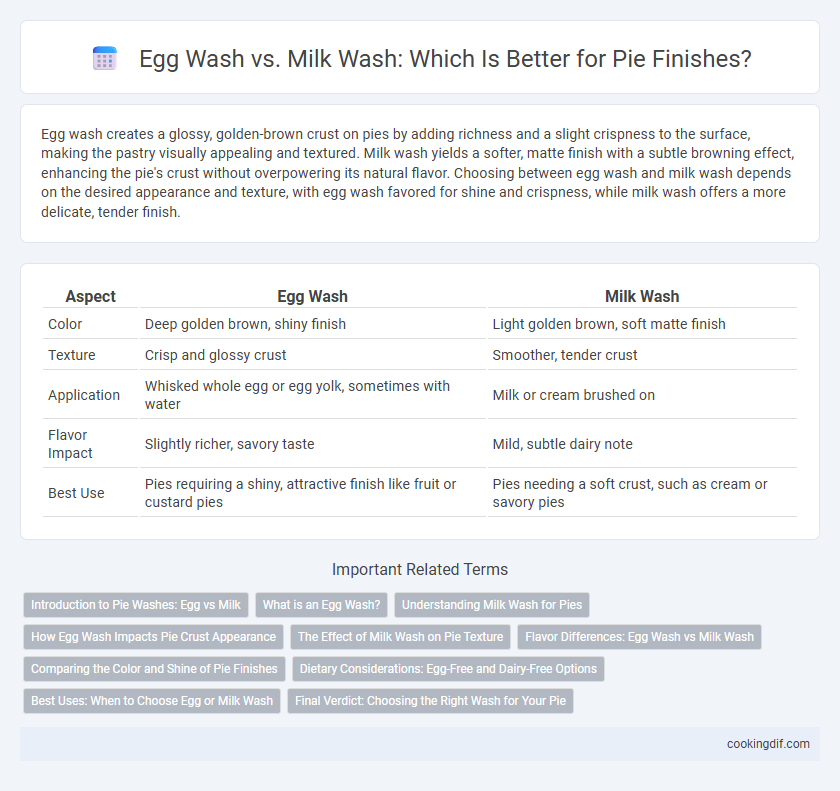Egg wash creates a glossy, golden-brown crust on pies by adding richness and a slight crispness to the surface, making the pastry visually appealing and textured. Milk wash yields a softer, matte finish with a subtle browning effect, enhancing the pie's crust without overpowering its natural flavor. Choosing between egg wash and milk wash depends on the desired appearance and texture, with egg wash favored for shine and crispness, while milk wash offers a more delicate, tender finish.
Table of Comparison
| Aspect | Egg Wash | Milk Wash |
|---|---|---|
| Color | Deep golden brown, shiny finish | Light golden brown, soft matte finish |
| Texture | Crisp and glossy crust | Smoother, tender crust |
| Application | Whisked whole egg or egg yolk, sometimes with water | Milk or cream brushed on |
| Flavor Impact | Slightly richer, savory taste | Mild, subtle dairy note |
| Best Use | Pies requiring a shiny, attractive finish like fruit or custard pies | Pies needing a soft crust, such as cream or savory pies |
Introduction to Pie Washes: Egg vs Milk
Egg wash and milk wash are popular finishing techniques for pies that enhance crust appearance and texture. Egg wash, made from beaten eggs sometimes mixed with water or milk, produces a glossy, golden-brown finish with added crispness. Milk wash tends to create a softer, matte finish with subtle browning, ideal for a more tender crust surface.
What is an Egg Wash?
An egg wash is a mixture of beaten eggs, sometimes combined with water or milk, brushed onto pie crusts before baking to create a golden, glossy finish. It enhances browning by promoting Maillard reactions during baking, resulting in a visually appealing and slightly crisp texture. Egg wash is preferred over milk wash when a more vibrant color and shine are desired on pies.
Understanding Milk Wash for Pies
Milk wash enhances pie crusts by promoting a glossy, golden-brown finish while providing a subtle, tender texture. Unlike egg wash, milk wash lacks proteins that create a strong shine but offers a more delicate sheen and softer crust. Using whole milk or cream can increase richness and improve browning through the lactose content.
How Egg Wash Impacts Pie Crust Appearance
Egg wash, composed of beaten eggs sometimes mixed with water or milk, enhances the pie crust by producing a glossy, golden-brown finish that highlights texture and detail. The protein content in eggs promotes browning through the Maillard reaction, resulting in a richer color and appealing shine compared to milk wash. This finish helps create a visually striking crust that signals freshness and careful preparation.
The Effect of Milk Wash on Pie Texture
Milk wash enhances pie crust texture by promoting a tender, golden-brown finish with subtle gloss. Its natural sugars caramelize during baking, creating a slightly softer and more delicate crust compared to egg wash. Using milk wash results in a less shiny but more evenly cooked surface, ideal for pies seeking a balanced texture without a heavy glaze.
Flavor Differences: Egg Wash vs Milk Wash
Egg wash imparts a rich, savory flavor with a slightly toasted, golden crust that enhances the overall pie experience. Milk wash offers a milder, creamier taste and produces a softer, more matte finish without the pronounced crispiness of egg wash. Flavor profiles differ significantly, with egg wash providing a bold, glossy appearance and milk wash contributing subtle sweetness and tenderness to the pie crust.
Comparing the Color and Shine of Pie Finishes
Egg wash creates a deep golden-brown color and a glossy, reflective shine on pie crusts due to the protein and fat content reacting during baking. Milk wash typically results in a softer, lighter golden hue with a more subtle, matte finish because of its lower protein concentration and natural sugars. Bakers often choose egg wash for an intense, rich color and high shine, while milk wash is favored for a gently browned crust with a delicate gloss.
Dietary Considerations: Egg-Free and Dairy-Free Options
Egg wash, typically made from beaten eggs, provides a shiny, golden finish but is unsuitable for those with egg allergies or following vegan diets. Milk wash offers a similar gloss with a softer sheen and is a dairy-containing alternative that can also trigger lactose intolerance or dairy allergies. For egg-free and dairy-free pie finishes, plant-based options like almond milk, soy milk, or aquafaba can create an appealing crust without compromising dietary restrictions.
Best Uses: When to Choose Egg or Milk Wash
Egg wash creates a glossy, golden-brown finish ideal for savory and sweet pies needing a rich, professional appearance, while milk wash produces a softer sheen with a subtle browning effect suited for delicate pastries and fruit pies. Use egg wash when a strong color contrast and crisp texture are desired, enhancing crust flakiness and visual appeal. Milk wash is best for tender, lightly browned crusts, providing moisture and a gentle shine without overpowering the pie's natural flavor.
Final Verdict: Choosing the Right Wash for Your Pie
Egg wash creates a glossy, golden-brown finish that enhances texture and enhances the pie's visual appeal, making it ideal for fruit and savory pies. Milk wash produces a softer, matte crust with a subtle sheen, perfect for delicate pastries and custard pies. Choosing the right wash depends on the desired crust appearance and texture, with egg wash offering a richer, more vibrant finish and milk wash providing a gentle, tender crust.
Egg wash vs milk wash for pie finishes Infographic

 cookingdif.com
cookingdif.com